- Joined
- Jul 1, 2014
- Messages
- 3,694 (0.97/day)
CES may have officially ended but our coverage from the trade show continues. Bitspower had invited TechPowerUp to come visit their suite, mentioning there would be something new and unexpected, and that indeed was the case. Our tour began with the customary showcase of the new GPU water blocks compatible with reference, and board partner designs, for the new NVIDIA GeForce RTX 2060 and relatively new AIC RTX 2070/80(Ti) cards as well. These feature integrated RGB lighting compatible with all major motherboard lighting solutions for control, and adopt the split central-inlet flow design as well.



Next to these were some new product designs that included OLED displays and sensors- a large Bitspower branded CPU water block that had an integrated temperature and flow sensor that could be read off the display as seen in the image below, and also a TouchAqua (Bitspower's more budget-friendly brand) standalone temperature sensor with integrated display. Bitspower's plans include adopting such displays and sensors across their product range of CPU, GPU and motherboard blocks as well.
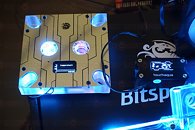



Next up came the fans, one design in a black or white rotor color option that the company is still undecided on whether to bring both to retail channels or not. As with any custom water cooling product these days, the new fans include RGB lighting via multiple individually addressable digital RGB LEDs integrated in the fan frame. More interestingly, the rotor itself adopts a dual blade design that Bitspower says will help reduce the deadspot in airflow around the fan fun and increase static pressure as well. We have seen version of this design used before, often not to good effect, and we will be sure to test these out for ourselves when they release to market. These fans can be daisy-chained together via short extension cables allowing so, allowing multiple fans to run off the same fan header pending power limitations.

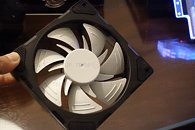

Acknowledging that end users may want to run many such LED fans in a custom watercooled case, and not have enough LED headers for each of them even with daisy-chaining in use, Bitspower also showed off an LED hub that is powered from the PSU via a full size SATA connector, and is capable of running up to eight 4-pin RGB LED devices. Analogous to this is also an upcoming PWM hub, which is similar to existing solutions and is Bitspower's product for those who want to stick to the brand. The PWM hub can power up to 10 4-pin PWM devices, and is best to be used with the same device (fans, for example).


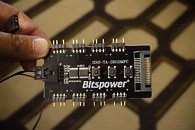

We covered recently Bitspower's fairly unique custom reservoir and pump for the Lian Li PC-O11 dynamic, and the company had more to show on this lineup with support for added Lian Li and InWin cases. This section also included a concept that had a custom reservoir, radiator, pump and fans all integrated to allow for a space-efficient, neat-looking cooling solution. These products come with drain and fill port fittings, the latter of which also has an air-check valve integrated to ensure no pressure is built up, thus retaining structural integrity.





Be with from TouchAqua or the parent Bitspower brand, the company wanted to also indicate clearly that they will continue to support more budget-friendly options via simpler designed CPU blocks. Pricing will be key here, since such a coldplate design is reminiscent of the previous decade. At the same time, they also showed that they can support a plethora of different colors and finishes across their premium product line- fittings, reservoir end caps and brackets, and so on for added customization potential. Most of these already exist on the market, and can be purchased directly from them or their retailers.


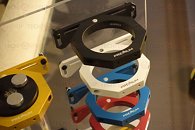


Saving what was arguably the most interesting showing from Bitspower for last, we saw their own take on a GPU pot for LN2 cooling. Indeed, retail packaging was ready as well although they were quick to say there is no estimate on when this will come to market, if at all. The Bitspower GPU LN2 pot sample uses a two-piece construction, allowing a monochrome color scheme with the Bitspower logo at the top and a massive chunk of copper at the bottom. If you have handled an LN2 pot before, you know what to expect but for others- this weighs a lot owing to the much higher amount of copper used here relative to an average water block. Indeed, we see plated copper in most places but the channels inside as well as the contact plate are still bare copper for that extra bit of thermal performance.
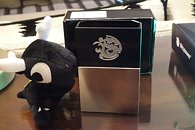
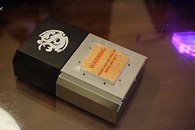


View at TechPowerUp Main Site



Next to these were some new product designs that included OLED displays and sensors- a large Bitspower branded CPU water block that had an integrated temperature and flow sensor that could be read off the display as seen in the image below, and also a TouchAqua (Bitspower's more budget-friendly brand) standalone temperature sensor with integrated display. Bitspower's plans include adopting such displays and sensors across their product range of CPU, GPU and motherboard blocks as well.




Next up came the fans, one design in a black or white rotor color option that the company is still undecided on whether to bring both to retail channels or not. As with any custom water cooling product these days, the new fans include RGB lighting via multiple individually addressable digital RGB LEDs integrated in the fan frame. More interestingly, the rotor itself adopts a dual blade design that Bitspower says will help reduce the deadspot in airflow around the fan fun and increase static pressure as well. We have seen version of this design used before, often not to good effect, and we will be sure to test these out for ourselves when they release to market. These fans can be daisy-chained together via short extension cables allowing so, allowing multiple fans to run off the same fan header pending power limitations.



Acknowledging that end users may want to run many such LED fans in a custom watercooled case, and not have enough LED headers for each of them even with daisy-chaining in use, Bitspower also showed off an LED hub that is powered from the PSU via a full size SATA connector, and is capable of running up to eight 4-pin RGB LED devices. Analogous to this is also an upcoming PWM hub, which is similar to existing solutions and is Bitspower's product for those who want to stick to the brand. The PWM hub can power up to 10 4-pin PWM devices, and is best to be used with the same device (fans, for example).




We covered recently Bitspower's fairly unique custom reservoir and pump for the Lian Li PC-O11 dynamic, and the company had more to show on this lineup with support for added Lian Li and InWin cases. This section also included a concept that had a custom reservoir, radiator, pump and fans all integrated to allow for a space-efficient, neat-looking cooling solution. These products come with drain and fill port fittings, the latter of which also has an air-check valve integrated to ensure no pressure is built up, thus retaining structural integrity.





Be with from TouchAqua or the parent Bitspower brand, the company wanted to also indicate clearly that they will continue to support more budget-friendly options via simpler designed CPU blocks. Pricing will be key here, since such a coldplate design is reminiscent of the previous decade. At the same time, they also showed that they can support a plethora of different colors and finishes across their premium product line- fittings, reservoir end caps and brackets, and so on for added customization potential. Most of these already exist on the market, and can be purchased directly from them or their retailers.





Saving what was arguably the most interesting showing from Bitspower for last, we saw their own take on a GPU pot for LN2 cooling. Indeed, retail packaging was ready as well although they were quick to say there is no estimate on when this will come to market, if at all. The Bitspower GPU LN2 pot sample uses a two-piece construction, allowing a monochrome color scheme with the Bitspower logo at the top and a massive chunk of copper at the bottom. If you have handled an LN2 pot before, you know what to expect but for others- this weighs a lot owing to the much higher amount of copper used here relative to an average water block. Indeed, we see plated copper in most places but the channels inside as well as the contact plate are still bare copper for that extra bit of thermal performance.




View at TechPowerUp Main Site


